[English] 日本語
 Yorodumi
Yorodumi- PDB-1eyu: HIGH RESOLUTION STRUCTURE OF THE PVUII ENDONCULEASE/COGNATE DNA C... -
+ Open data
Open data
- Basic information
Basic information
| Entry | Database: PDB / ID: 1eyu | ||||||
|---|---|---|---|---|---|---|---|
| Title | HIGH RESOLUTION STRUCTURE OF THE PVUII ENDONCULEASE/COGNATE DNA COMPLEX AT PH 4.6 | ||||||
 Components Components |
| ||||||
 Keywords Keywords | hydrolase/DNA / PROTEIN-DNA COMPLEX / endonuclease type II / restriction enzyme / hydrolase-DNA COMPLEX | ||||||
| Function / homology |  Function and homology information Function and homology informationtype II site-specific deoxyribonuclease / type II site-specific deoxyribonuclease activity / DNA restriction-modification system / DNA binding / metal ion binding Similarity search - Function | ||||||
| Biological species |  Proteus vulgaris (bacteria) Proteus vulgaris (bacteria) | ||||||
| Method |  X-RAY DIFFRACTION / Resolution: 1.78 Å X-RAY DIFFRACTION / Resolution: 1.78 Å | ||||||
 Authors Authors | Horton, J.R. / Cheng, X. | ||||||
 Citation Citation |  Journal: J.Mol.Biol. / Year: 2000 Journal: J.Mol.Biol. / Year: 2000Title: PvuII endonuclease contains two calcium ions in active sites. Authors: Horton, J.R. / Cheng, X. #1:  Journal: J.Mol.Biol. / Year: 1998 Journal: J.Mol.Biol. / Year: 1998Title: Asp34 of PvuII Endonuclease is directly involved in DNA minor groove recognition and indirectly involved in catalysis Authors: Horton, J.R. / Nastri, H.G. / Riggs, P.D. / Cheng, X. #2:  Journal: Biol.Chem. / Year: 1998 Journal: Biol.Chem. / Year: 1998Title: How is modification of the DNA substrate recognized by the PvuII restriction endonuclease? Authors: Horton, J.R. / Bonventre, J. / Cheng, X. | ||||||
| History |
|
- Structure visualization
Structure visualization
| Structure viewer | Molecule:  Molmil Molmil Jmol/JSmol Jmol/JSmol |
|---|
- Downloads & links
Downloads & links
- Download
Download
| PDBx/mmCIF format |  1eyu.cif.gz 1eyu.cif.gz | 97.2 KB | Display |  PDBx/mmCIF format PDBx/mmCIF format |
|---|---|---|---|---|
| PDB format |  pdb1eyu.ent.gz pdb1eyu.ent.gz | 71.5 KB | Display |  PDB format PDB format |
| PDBx/mmJSON format |  1eyu.json.gz 1eyu.json.gz | Tree view |  PDBx/mmJSON format PDBx/mmJSON format | |
| Others |  Other downloads Other downloads |
-Validation report
| Summary document |  1eyu_validation.pdf.gz 1eyu_validation.pdf.gz | 433.8 KB | Display |  wwPDB validaton report wwPDB validaton report |
|---|---|---|---|---|
| Full document |  1eyu_full_validation.pdf.gz 1eyu_full_validation.pdf.gz | 438.6 KB | Display | |
| Data in XML |  1eyu_validation.xml.gz 1eyu_validation.xml.gz | 18.6 KB | Display | |
| Data in CIF |  1eyu_validation.cif.gz 1eyu_validation.cif.gz | 27.9 KB | Display | |
| Arichive directory |  https://data.pdbj.org/pub/pdb/validation_reports/ey/1eyu https://data.pdbj.org/pub/pdb/validation_reports/ey/1eyu ftp://data.pdbj.org/pub/pdb/validation_reports/ey/1eyu ftp://data.pdbj.org/pub/pdb/validation_reports/ey/1eyu | HTTPS FTP |
-Related structure data
- Links
Links
- Assembly
Assembly
| Deposited unit | 
| ||||||||||
|---|---|---|---|---|---|---|---|---|---|---|---|
| 1 |
| ||||||||||
| Unit cell |
| ||||||||||
| Details | The biological assembly is the endonuclease dimer (chain A and chain B) and doubled-stranded oligonucleotide (chain C and chain D). |
- Components
Components
| #1: DNA chain | Mass: 3967.585 Da / Num. of mol.: 2 / Source method: obtained synthetically Details: SELF-ANNEALING OLIGONUCLEOTIDE CONTAINING COGNATE SIX BASE PAIR SEQUENCE #2: Protein | Mass: 18370.992 Da / Num. of mol.: 2 Source method: isolated from a genetically manipulated source Source: (gene. exp.)  Proteus vulgaris (bacteria) / Plasmid: PPR594 / Production host: Proteus vulgaris (bacteria) / Plasmid: PPR594 / Production host:  References: UniProt: P23657, type II site-specific deoxyribonuclease #3: Water | ChemComp-HOH / | |
|---|
-Experimental details
-Experiment
| Experiment | Method:  X-RAY DIFFRACTION / Number of used crystals: 1 X-RAY DIFFRACTION / Number of used crystals: 1 |
|---|
- Sample preparation
Sample preparation
| Crystal | Density Matthews: 2.03 Å3/Da / Density % sol: 39.34 % | ||||||||||||||||||||||||||||||||||||||||||||||||||||||||
|---|---|---|---|---|---|---|---|---|---|---|---|---|---|---|---|---|---|---|---|---|---|---|---|---|---|---|---|---|---|---|---|---|---|---|---|---|---|---|---|---|---|---|---|---|---|---|---|---|---|---|---|---|---|---|---|---|---|
| Crystal grow | Temperature: 289 K / Method: vapor diffusion, hanging drop / pH: 4.5 Details: PEG 4000, sodium acetate, CaCl2, pH 4.5, VAPOR DIFFUSION, HANGING DROP, temperature 289K | ||||||||||||||||||||||||||||||||||||||||||||||||||||||||
| Components of the solutions |
| ||||||||||||||||||||||||||||||||||||||||||||||||||||||||
| Crystal grow | *PLUS Temperature: 16 ℃Details: Balendiran, K., (1994) Proteins: Struct. Funct. Genet., 19, 77. | ||||||||||||||||||||||||||||||||||||||||||||||||||||||||
| Components of the solutions | *PLUS
|
-Data collection
| Diffraction | Mean temperature: 95 K |
|---|---|
| Diffraction source | Source:  ROTATING ANODE / Type: RIGAKU RU300 / Wavelength: 1.5418 ROTATING ANODE / Type: RIGAKU RU300 / Wavelength: 1.5418 |
| Detector | Type: RIGAKU RAXIS IV / Detector: IMAGE PLATE / Date: Jan 12, 1999 |
| Radiation | Protocol: SINGLE WAVELENGTH / Monochromatic (M) / Laue (L): M / Scattering type: x-ray |
| Radiation wavelength | Wavelength: 1.5418 Å / Relative weight: 1 |
| Reflection | Resolution: 1.78→25 Å / Num. all: 35254 / Num. obs: 35254 / % possible obs: 98 % / Observed criterion σ(F): 0 / Observed criterion σ(I): 0 / Redundancy: 3.7 % / Biso Wilson estimate: 17.2 Å2 / Rmerge(I) obs: 0.045 / Net I/σ(I): 3621.7 |
| Reflection shell | Resolution: 1.78→1.81 Å / Redundancy: 2.4 % / Rmerge(I) obs: 0.198 / Num. unique all: 1686 / % possible all: 96.5 |
| Reflection | *PLUS Num. measured all: 130055 |
| Reflection shell | *PLUS % possible obs: 96.5 % |
- Processing
Processing
| Software |
| |||||||||||||||||||||||||
|---|---|---|---|---|---|---|---|---|---|---|---|---|---|---|---|---|---|---|---|---|---|---|---|---|---|---|
| Refinement | Resolution: 1.78→25 Å / Data cutoff high absF: 100000 / Cross valid method: THROUGHOUT / σ(F): 0 / σ(I): 0 / Stereochemistry target values: Engh & Huber
| |||||||||||||||||||||||||
| Refinement step | Cycle: LAST / Resolution: 1.78→25 Å
| |||||||||||||||||||||||||
| Refine LS restraints |
|
 Movie
Movie Controller
Controller


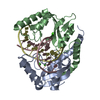


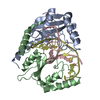
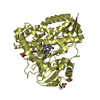
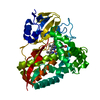
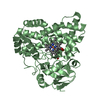

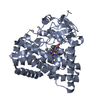

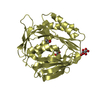


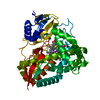
 PDBj
PDBj







































